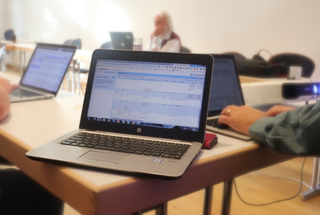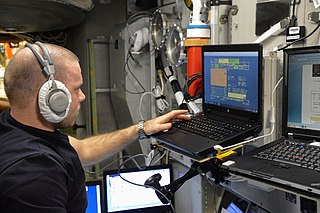
Dell Inc. is an American based technology company. It develops, sells, repairs, and supports computers and related products and services. Dell is owned by its parent company, Dell Technologies.
In computer architecture, 64-bit integers, memory addresses, or other data units are those that are 64 bits wide. Also, 64-bit CPUs and ALUs are those that are based on processor registers, address buses, or data buses of that size. A computer that uses such a processor is a 64-bit computer.
The NX bit (no-execute) is a technology used in CPUs to segregate areas of a virtual address space for use by either storage of processor instructions or for storage of data. An operating system with support for the NX bit may mark certain areas of an address space as non-executable. The processor will then refuse to execute any code residing in these areas of the address space. The general technique, known as executable space protection, also called Write XOR Execute, is used to prevent certain types of malicious software from taking over computers by inserting their code into another program's data storage area and running their own code from within this section; one class of such attacks is known as the buffer overflow attack.
The thermal design power (TDP), sometimes called thermal design point, is the maximum amount of heat generated by a computer chip or component that the cooling system in a computer is designed to dissipate under any workload.
Green computing, green IT, or ICT sustainability, is the study and practice of environmentally sustainable computing or IT.
The Climate Savers Computing Initiative was a nonprofit group of consumers, businesses and conservation organizations dedicated to promoting smart technologies that improve power efficiency and reduce energy consumption of computers. Formed in 2007, it was based in Portland, Oregon. In July 2012, Climate Savers Computing Initiative combined with The Green Grid and its programs continue within that organization.
In computing, performance per watt is a measure of the energy efficiency of a particular computer architecture or computer hardware. Literally, it measures the rate of computation that can be delivered by a computer for every watt of power consumed. This rate is typically measured by performance on the LINPACK benchmark when trying to compare between computing systems: an example using this is the Green500 list of supercomputers. Performance per watt has been suggested to be a more sustainable measure of computing than Moore’s Law.
The Green500 is a biannual ranking of supercomputers, from the TOP500 list of supercomputers, in terms of energy efficiency. The list measures performance per watt using the TOP500 measure of high performance LINPACK benchmarks at double-precision floating-point format.
Power usage effectiveness (PUE) is a ratio that describes how efficiently a computer data center uses energy; specifically, how much energy is used by the computing equipment.
Data center infrastructure efficiency (DCIE), is a performance improvement metric used to calculate the energy efficiency of a data center. DCIE is the percentage value derived, by dividing information technology equipment power by total facility power.

HP EliteBook is a line of business-oriented high-end notebooks and mobile workstations made by Hewlett-Packard. The EliteBook series, which fits above the lower-end ProBook series, was introduced in August 2008 as a replacement of the HP Compaq high end line of notebooks. The EliteBook brand included mobile workstations until September 2013, when they were rebranded as HP ZBook. The EliteBook mainly competes against computer lineups such as Acer's TravelMate, Dell's Latitude and Precision, Lenovo's ThinkPad and Toshiba's Portégé and Tecra.
The IEEE Corporate Innovation Recognition was established by the IEEE Board of Directors in 1985. This award is presented for outstanding and exemplary contributions by an industrial entity, governmental, or academic organization, or other corporate body.
Green Power Usage Effectiveness (GPUE) is a proposed measurement of both how much sustainable energy a computer data center uses, its carbon footprint per usable kilowatt hour (kWh) and it uses its power; specifically, how much of the power is actually used by the computing equipment. It is an addition to the power usage effectiveness (PUE) definition and was first proposed by Greenqloud.

The Open Compute Project (OCP) is an organization that shares designs of data center products and best practices among companies, including ARM, Meta, IBM, Wiwynn, Intel, Nokia, Google, Microsoft, Seagate Technology, Dell, Rackspace, Hewlett Packard Enterprise, NVIDIA, Cisco, Goldman Sachs, Fidelity, Lenovo and Alibaba Group.

HP ZBook is a brand of mobile workstations made by HP Inc. Introduced in September 2013, it is a successor to HP's previous mobile workstations in the HP EliteBook series. The ZBook mainly competes against PCs such as Dell's Precision and Lenovo's ThinkPad P Series.
Water Usage Effectiveness (WUE) is a sustainability metric created by The Green Grid in 2011 to attempt to measure the amount of water used by datacenters to cool their IT assets. To calculate simple WUE, a data center manager divides the annual site water usage in liters by the IT equipment energy usage in kilowatt hours (Kwh). Water usage includes water used for cooling, regulating humidity and producing electricity on-site. More complex WUE calculations are available from The Green Grid website.
Coherent Accelerator Processor Interface (CAPI), is a high-speed processor expansion bus standard for use in large data center computers, initially designed to be layered on top of PCI Express, for directly connecting central processing units (CPUs) to external accelerators like graphics processing units (GPUs), ASICs, FPGAs or fast storage. It offers low latency, high speed, direct memory access connectivity between devices of different instruction set architectures.

A green data center, or sustainable data center, is a service facility which utilizes energy-efficient technologies. They do not contain obsolete systems, and take advantage of newer, more efficient technologies.
Data center management is the collection of tasks performed by those responsible for managing ongoing operation of a data center. This includes Business service management and planning for the future.




